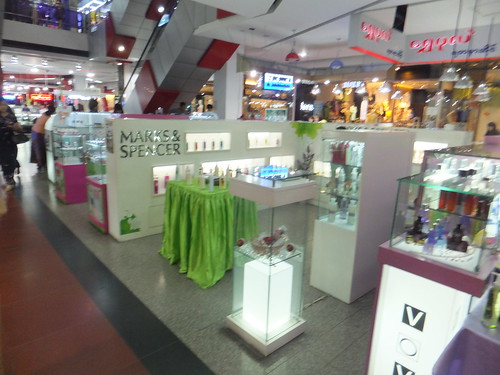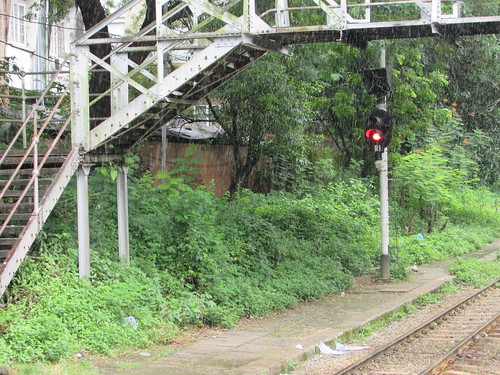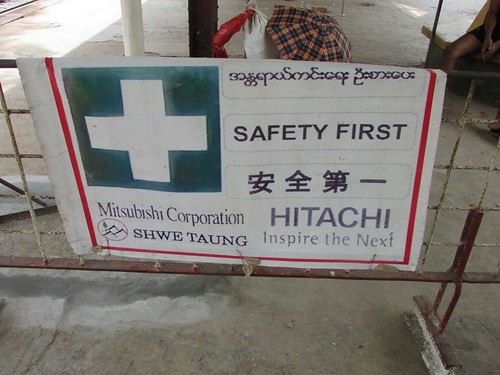I slept well again on Monday night and took a fairly early breakfast. I had two ideas in mind for my final day. The first was book purchases, the second rail travel.
Book buying
During previous visits, I'd learnt that the TAB Book Centre in the Taw Win Shopping Centre carried a good range of books in English about Myanmar, particularly reprints of recollections by English people who'd spent time in the territory. I'd already assembled a small collection (there's a bibliography in the post Kipling's Burma) and my aim was to extend this collection.
The Taw Win Centre is a shopping mall and hotel complex just 700 metres from the Belmond Governor's Residence so, breakfast completed, I set out on foot. The Taw Win Centre is bounded by Pyay Road, a minor road and the railway line at Pyay Road Station, so the floor plan is a right-angled triangle which invariably confuses me as I work through the various floors looking for the TAB Book Centre which is located on the third floor. The well-stocked bookshop also sells computer equipment.

Yangon: Taw Win Shopping Mall in 2012.
An English-speaking assistant directed me to the section of books in English. I'd remembered that the store carried a wide range of Buddhist books so it seemed appropriate that the shop's sound system was playing a recording of a monk intoning a sacred text. However, after about five minutes, in a rather jarring change, the monk was replaced by a modern 'pop' song. I'd taken the precaution of taking a list of books already in my collection, in the hope of avoiding duplication but there were still plenty of interesting-looking titles to choose from. Having completed my selection, I completed my purchases in cash. Whilst credit cards are now far more widely accepted in Myanmar than a few years ago, the TAB Book Centre remains a cash establishment. I walked back to the hotel, warm but delighted with my new books.
Rail travel
A new port, operated by Hutchison Ports, has been established at Thilawa, a little downstream from Yangon city and the old docks. 'Yangon' is now a cruise destination but the cruise ships invariably actually dock at Thilawa. I'd seen the new port from afar when I visited Kyaik Khauk Pagoda in 2016 (see the post Visiting Pagodas. Elaborate enquiries had suggested that there was just one train each day from Yangon Central Station to Thilawa, leaving at 12:15 in the afternoon and not returning until the evening. Each time I'd considered attempting this journey, something had intervened to prevent me. So, with an unexpected surge of confidence, having succeeded in my book purchases, I took a cab to Yangon Central Station and made my way to the suburban booking office on platform 6/7 where they speak some English.

Thilawa Port viewed from Kyaik Khauk Pagoda.
In the hope of avoiding confusion, I'd written the destination, time and ticket price (in 'Roman' characters) on a piece of paper. The ticket clerk confirmed that my information was correct, and immediately issued me with a ticket (but written in Myanmar characters). With suburban trains coming and going regularly, identifying the correct departure remained a problem but the ticket clerk assured me that he would alert me to the right train. A few minutes later, the clerk re-appeared and directed me to a Diesel Multiple Unit standing in the Western part of the platform. Since my destination was east, I queried this. "Thilawa, Thilawa" he re-assured me. Well, I knew that some eastbound trains started from the western end of the platform so I felt I had no alternative but to board the indicated train. Almost immediately, an inspection of tickets took place. The ticket inspector studied my ticket very carefully but was satisfied so I once again enquired whether the train was for Thilawa. He was emphatic that it was, just before the train set off westwards on a long clockwise circuit of the Circle line which didn't take me to Thilawa.
I still don't know what went wrong with my careful arrangements except that travelling on the Circle Line is something of a 'Rite of Passage' for many foreign tourists, so perhaps they just thought 'Foreign Tourist - Put her on the next Circle Line Train'. I never tire of watching the passing scene on the Circle Line so, lacking the energy to bound off the train and plan another adventure, I meekly accepted my fate and travelled around most of the Circle Line. A further discouragement was that it was raining quite heavily as we left Yangon Central, although it dried-up later in the journey.

The Circle Line (Yangon - Mahlwagon c/w): Leaving Yangon in heavy rain.
Signalling on the Circle Line
Yangon's Circle Line is described in the post here. It is double track throughout, signalled by a variety of 2-aspect and 3-aspect colour light signals from a number of signal cabins with intermediate sections controlled by Automatic Block.
Yangon Central Station is still controlled by an elderly British-made Westinghouse Style 'L' miniature lever frame, described here.
Kyee Myin Daing remains a delight for me with two mechanical signal boxes (North and South), facing points provided with Facing Point Locks/Locking Bars and semaphore signals on the sidings. There's a description here and a report on an official visit here.
Insein has a Korean 'NX' (eNtrance-eXit) signalling panel also described here.
Da Nyn Gone has a locally-built signalling panel controlled by miniature switches, described here.
Mingalardon has another locally-built signalling panel controlled by miniature pushbuttons, mentioned in my report on an official visit here.
Paywet Seik Kone also has a locally-built push-button signalling panel, mentioned in my report on an official visit here.
My very first trip on the Circle Line in 2008 piqued my interest in the railways between Mahlwagon and Pazundaung. At Mahlwagon, the double track Circle Line joins the double track main line from Mandalay and there is quadruple track from there to Pazundaung, as shown in the diagram below. At Mahlwagon, a double junction gives access to the large Mahlwagon Marshalling Yard (an official visit is described here). At Pazundaung, two lines emerge from the Marshalling Yard and tangle with the other lines at the complex ‘flat crossing’ junction where trains to and from the Circle Lines cross the Up and Down Bago and Mandalay main lines as they pass from or to the local lines. This is because, at Yangon Central, long distance trains use platforms 1, 2, and 3 on the north side of the station whilst local trains usually use platforms 4, 5, 6 and 7 on the south side. There's the further complication, west of Pazundaung, of the splitting of the Down and Up Goods Lines (which by-pass Yangon Central Station to the south) and the junction to the single line branch to the old docks along Strand Road.

Myanma Railways: Simplified line diagram Pazundaung to Mahlwagon
Click for larger version
At the time of my official visit in 2017 mentioned above, I thought it likely that Pazundaung and Mahlwagon had similar locally-built installations but this is not correct. My German friend Dieter later wrote that Siemens modernised these areas in the 1960s as part of the Circle Line colour-light project. Certainly, when I checked my photographic record, I confirmed that, in the Mahlwagon and Pazundaung area, electric point machines and colour light signal heads are Siemens built. There is some ambiguity over the signal numbers originally carried on the posts (There appeared to be two signals 'M25'!) but the prefixes used 'M' and 'P' suggested two control panels. A further oddity is that three colour light signals at Mahlwagon carry line-of-white-lights route indicators although there are currently no track connections between the Circle Lines and the Bago lines.
Time for gaining a better understanding of the present arrangements is getting shorter because, as I mentioned in my post here, the Japan International Cooperation Agency is involved in modernising Myanma Railways and I saw new location cases and point machines in the Pazundaung area.

The Japanese railway modernisation project is well in evidence around Yangon.
Mahlwagon
It took my Circle Line train about two and a half hours to reach Mahlwagon, on the interesting four-track section described above. I decided to leave the train and explore the area around the station on foot, taking a number of pictures before returning to the station to catch the next service back to Yangon Central.

Mahlwagon Main Line seen from the north end of the Up Yard showing Train Number 5 Up (the 15:00 hours Yangon-Mandalay, due to arrive 05:00 the following day) with a Chinese-built Bo-Bo-Bo on a rake of Chinese-built 'air-bag suspension' coaches.
By this time, I was rather tired so, after a short period watching movements around the station, I made my way outside to find a taxi. I'd had an enjoyable and informative afternoon, even if it wasn't as planned. I was able to use my comfortable room at the Belmond Governor's Residence until 11.30 p.m., when the hotel car was transferring me to Mingalardon Airport. I spent the evening packing, drinking tea and trying to relax before my long night flight home.
Related posts on this website
This is one of a series of posts describing my 12th visit to Myanmar. The post Starting out is the first post in the series.
Clicking on the 'Next report' link displays the post describing the next events. In this way, you may read about the trip in sequence.
Next report.
Alternately, clicking on the 'All my Burma-2017(2) reports' link displays all the posts on this trip in reverse date-of-posting order.
All my Burma-2017(2) reports.
My photograph albums
Where necessary, clicking on an image above will display an 'uncropped' view or, alternately, pictures may be selected, viewed or downloaded, in various sizes, from the albums listed:-
The Governor's Residence Hotel, Yangon.
The Circle Line (Yangon - Mahlwagon c/w).
The Circle Line (Mahlwagon - Yangon Central Station c/w).
